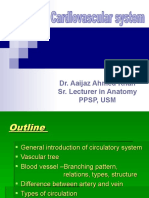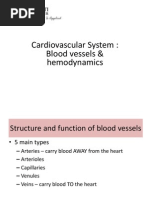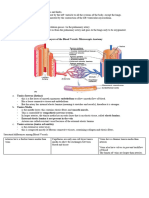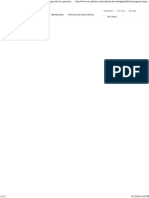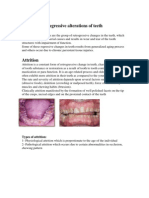' Chapter21_NotesSpr20
Uploaded by
sirley1414' Chapter21_NotesSpr20
Uploaded by
sirley1414Chapter 21 – Blood Vessels & Circulation
Notes
I. Arteries, Capillaries, and Veins [ONLINE]
The function of the circulatory system is to service the needs of the tissues: transport nutrients to tissues, transport waste
products away, conduct hormones from one part to another, and maintain appropriate environment in tissue fluids. Blood
circulates throughout the body via blood vessels. Arteries always carry blood away from the heart & veins always return
blood to the heart. Arteries & veins supplying the same region lie side by side.
Types of blood vessels (Summary)
Blood Vessel Description
Part of the arterial circulation and responsible for transporting blood away from the heart to the
tissues. Arteries are closer to the pumping action of the heart so their walls must be strong
enough to take the continuous changes in pressure.
Part of the microcirculation. The function of the capillaries is the exchange fluid, nutrients,
electrolytes, hormones, and blood gases between the blood and interstitial fluid.
Part of the venous circulation and responsible for the collection of blood from the capillaries &
returning it to the heart. Veins are far from the heart and the pressure tends to be low all the time
therefore the walls are thinner.
A. Types of blood vessels [ONLINE]
Arterial System
1. Arteries - Thick muscular walls give elasticity & contractility. Elasticity allows vessels to respond to & dampen
changes in blood pressure due to heart pumping. Contractility allows constriction & vasodilation in response to nervous
system.
________________________ - large vessels designed to transport large volumes of blood to major body regions.
Tunica media contains large proportions of elastic fibers & smaller proportion of smooth muscle. In response to
ventricular systole, vessels expand to accommodate blood from heart & dampen increased pressure. As blood
moves through vessels & ventricles enter diastole, vessels contract & dampen pressure drop. By the time blood
reaches arterioles, fluctuations in pressure are eliminated.
_________________________ - distribute blood throughout muscles & organs. Contain a higher proportion of
muscle than elastic arteries.
2. Arterioles - Described as a narrow artery. Has a lot of circular smooth muscle in its wall. When muscle contracts,
diameter of arteriole narrows. When muscle relaxes, arteriole dilates. Constriction & dilation of arterioles controls blood
flow to capillaries.
3. Capillaries - Most numerous, narrowest, & thinnest-walled blood vessels. Have very thin walls (one cell layer thick)
to allow efficient gas exchange between blood & surrounding tissues. No tunica media or tunica externa. Function as part
of interconnected networks (capillary beds).
____________________ regulate flow of blood through various capillaries. Thoroughfare channels are direct connections
between arterioles & venules that allow blood to bypass most of the capillaries in a capillary bed. Blood flow must be
carefully regulated to the parts of the body that need it. A human doesn’t have enough blood to fill all capillaries at once.
BIOL 2402_AMC8 Anatomy and Physiology II 1
______________________________ - most common and most abundant in skin & muscles. Site of diffusion of
water, small solutes, & lipid-soluble materials, however, blood cells and plasma proteins do not cross.
Endothelial cells of these capillaries form a continuous lining and are held together with tight junctions, but there
are gaps that allow small amounts of fluid to pass between cells. An exception is in the brain capillaries, where
tight junctions form a complete barrier (blood–brain barrier) to movement of fluids between cells.
______________________________ - contain endothelial cells that have pores. Pores make capillaries
considerably more permeable to fluids and permit the rapid exchange of water, larger solutes between the plasma
and interstitial fluid. Typically found where active absorption of materials into blood is required, (e.g. small
intestine, endocrine organs, choroid plexus). Found in the kidneys where filtration occurs.
______________________________ - a special type of capillary. These capillaries have open spaces between
endothelial cells and are very permeable allowing for the free exchange of water and solutes (e.g. plasma
proteins). Found in the liver, bone marrow, pituitary, and adrenal glands.
What controls the movement of materials into & out of the blood?
_________________________________________ Substances diffuse in and out of the blood down their
concentration gradient (greater concentration to lesser concentration). Blood pressure in capillaries will force
materials into the tissues (filtration).
Venous System
1. Venules - narrow veins that collect blood from capillaries & carry blood to veins.
2. Veins – thin walls & wide lumen and can hold a lot of blood. Most of the circulating blood is located in the veins.
Because walls are less elastic than arteries, the blood pressure is very low, blood flows slowly & veins tend to expand to
accommodate the blood. Veins below heart level return blood to the heart against gravity. To keep blood flowing toward
the heart & counteract the downward pull of the blood by gravity, the veins below heart level have one-way flow valves
that open to allow blood to flow toward the heart & close if blood starts to flow backward.
Draw a diagram showing the order which the blood flows through vessels as it circulates from the heart back to the heart.
II. Differences between Arteries, Capillaries, and Veins
A. Vessel walls - Wall of artery usually much thicker than veins. Tunica media tends to be heavier. Elastic fibers in
walls of arteries make them distensible (stretchable) & resilient. Walls of arteries are wider than arterioles. Walls of
arterioles are wider than capillaries. Walls of veins are thinner than arteries & tunica externa is heaviest wall in veins.
Structure of Vessel Walls
Arteries & veins are the widest blood vessels. Structural difference is related to difference in function.
Arteries, arterioles, venules &veins - three layers of tissue in their walls.
Inner layer (layer against the blood) & composed of single layer of flattened epithelial
cells with an underlying basement membrane.
Middle layer & composed of an inner layer of elastic fibers & an outer layer of
circular smooth muscle.
Outer layer of blood vessel & is composed of collagenous fibers. Thickness of vessel
wall & diameter of lumen varies from one type of vessel to another.
Capillaries - wall contains only tunica intima & very thin outer layer of connective tissue.
BIOL 2402_AMC8 Anatomy and Physiology II 2
B. Vessel lumen - Diameter of artery lumen is narrower than vein. Walls of arteries are relatively strong & thick, &
keep circular shape. Lumens of veins tend to be larger, accommodating large volume of blood. When cut, veins tend to
collapse.
C. Vessel lining - Endothelium of artery can’t contract. When artery constricts, the endothelium “folds” to give a
pleated appearance. Veins don’t have these folds.
D. Veins typically contain valves - Blood pressure in veins may be sufficiently low that it cannot overcome the force of
gravity. Therefore, some venules & medium-sized veins contain valves, internal structures that prevent blood backflow.
Define:
Varicose veins -
Deep vein thrombosis (DVT) -
Pulmonary embolism -
III. Pressure &Resistance
Pressure - A fluid will flow through a tube as a result of differences in pressure at different points in the tube. Fluid
always flows from high pressure to low pressure (i.e., down a pressure gradient).
Blood flow (F) – amount (volume) of blood that passes through a vessel in a given unit of time (mL/sec). Blood flow (F)
is affected by 2 factors: Blood pressure (P) & Resistance (R).
Define:
Pressure -
Circulatory Pressure (CP) -
Blood Pressure (BP) -
Resistance (R) –
Draw a vessel with a pressure of 75mmHg at one end & 60mm Hg at the other & indicate the direction of blood flow.
What is the relationship between pressure (P) & flow (F). What is a proportional relationship?
If two vessels, A & B, have similar diameters & lengths but vessel A has a pressure of 110mm Hg & vessel B has a
pressure of 90mm Hg, which will fill a bucket faster & why? Draw this scenario.
Resistance (R) - Force that opposes movement. Vascular resistance are forces that oppose blood flow in blood vessels &
is largest component of total peripheral resistance. Most important factor in vascular resistance is friction between blood
& vessel walls. Two factors determine the amount of friction: Vessel length & vessel diameter.
BIOL 2402_AMC8 Anatomy and Physiology II 3
Vessel Diameter - Most resistance in fluid dynamics comes from the friction of fluid (blood) against vessel walls. The
narrower (constricted) a vessel is (decrease in diameter) the greater the resistance.
Draw two vessels, A & B, with vessel A having a greater diameter.
Assume the pressure & length of these vessels are the same. Which vessel has the greatest resistance?
What is the relationship between diameter & resistance? What is an inverse relationship?
What is the relationship between R & F?
The relationship between flow & diameter is not a direct relationship. Resistance is inversely proportional to vessel radius
to the 4th power. If vessel diameter decreases by ½, the resistance is 16X greater. A small decrease in vessel diameter can
result in a massive increase in resistance & a massive decrease in flow through the vessel. This is why arterioles, which
constrict & dilate, have a tremendous affect on blood flow to a tissue.
Vessel Length - Can increase resistance. Longer vessel = greater friction & resistance; lowering flow rate.
Draw two vessels of equal diameter but vessel A is longer than vessel B.
Which vessel will have the greatest resistance? The greater flow rate?
What is the relationship between vessel length & resistance? Length & flow?
Blood viscosity - Viscosity refers to thickness. A more viscous fluid is thicker & flows more slowly than a less viscous.
If blood becomes more viscous, as in leukemia, a disorder that affects hematocrit, or dehydration what effect would this
have on the arterial blood pressure? Pressure would rise. Why? Because heart has to pump harder to push blood through
blood vessels. The harder the pump works, the higher the blood pressure goes.
How does the viscosity of blood affect R & F?
Turbulence – An increase in resistance due to a change in the direction of flow of a fluid (or air). What is the
relationship between turbulence (T) & R?
What is the relationship between turbulence & flow?
BIOL 2402_AMC8 Anatomy and Physiology II 4
List three factors that increase turbulence in the blood stream:
1.
2.
3.
CLINICAL NOTE (pg 732): Arteriosclerosis - Read this section.
Define:
Arteriosclerosis -
Focal calcification -
Atherosclerosis -
List four factors that increase risks of arterio- and/or atherosclerosis:
1.
2.
3.
4.
5.
Overview of Cardiovascular Pressures
(Use Figure 21-8 to answer the following)
Which blood vessels have the smallest diameter?
Which blood vessels have the greatest total cross-sectional area?
Which blood vessels have the highest pressure?
Which blood vessels have the slowest blood flow?
Circulatory Pressure Gradient (Figure 21-9)
Write the pressure below each group of vessels in the following sequence:
Left ventricle Aorta Arteries Capillaries Veins Right atrium
Define:
Systolic Pressure -
Diastolic Pressure -
Pulse Pressure -
Hypertension –
Hypotension-
BIOL 2402_AMC8 Anatomy and Physiology II 5
What is defined as normal blood pressure?
Draw Vessel A under diastolic pressure & Vessel B under systolic pressure.
What is happening to diameter, resistance, & flow in vessel B?
What happens to a vessel during elastic rebound?
Why does blood pressure fluctuate in arteries?
Venous Pressure & Venous Return
What are venous valves & how do they assist venous return?
What is the muscular pump?
How does breathing assist venous return?
Capillary Pressures & Capillary Exchange
Major functions of capillaries: exchange of respiratory gases, O2 & CO2 via diffusion, filtration, & reabsorption.
Why are capillaries the only vessels that allow for exchange of substances like ions, nutrients, & gases between blood &
interstitial fluid/tissues?
Hydrostatic pressure (BHP) - Mechanical pressure acting on a fluid. Hydrostatic pressure tends to drive fluid out of
the capillaries, especially at the arterial end.
Hydrostatic pressure is:
• higher in _______________than ____________
• greater at arterial end of a capillary than at venous end
Along the entire length of the capillary, the hydrostatic pressure within the capillary (CHP) is generally greater than the
hydrostatic pressure in the interstitial spaces (IHP).
Osmotic pressure / Colloid osmotic pressure (BCOP) - Created by presence of large molecules (e.g. proteins) that
cannot diffuse across capillary wall. Colloid osmotic pressure tends to draw fluid into the capillaries. Molecules
attract H2O & create osmotic pressure. The concentration of molecules that create colloid osmotic pressure tends to be
greater in blood than interstitial spaces. Colloid osmotic pressure within capillary (BCOP) is generally greater than colloid
osmotic pressure in interstitial spaces (ICOP).
Net Filtration Pressure (NFP) - Difference between net Hydrostatic pressure & net Osmotic pressure.
NFP = BHP – BCOP
Calculate the NFP if BHP = 35mmHg & BCOP = 25mmHg
Which way will the net movement of fluid occur?
BIOL 2402_AMC8 Anatomy and Physiology II 6
Dynamic Center (DC) - of a capillary is the point where osmotic pressure equals hydrostatic pressure & no net fluid is
exchanged through capillary wall. Transition between filtration & reabsorption. (Term not used in the text).
On arteriole end of capillary the pressure is 35mm Hg & on venule end pressure is 18 mmHg. Below draw a vessel
indicating the BHP & BCOP throughout the length of the vessel. Indicate where the dynamic center would be located.
Is recall of fluids equal to the tissue perfusion? If not, what happens to the 15% of the fluid that is not recalled?
Draw a vessel to show what would happen to the dynamic center if BP decreased & BHP was 30mm Hg & BCOP is still
25mm Hg?
What happens if BHP increased to 40mm Hg at the arteriole end of the capillary?
What happens if BP & BHP are normal but BCOP decreases to 20mm Hg? What could cause this to happen?
READ: CLINICAL NOTE (pg 725): Edema
Complete the following table
Homeostatic Disruption Pressure Change in Vessel Change in Dynamic Resulting Fluid Movement
Center
High Blood Pressure BHP?
• Blocked vessel
• Increased blood volume
Low Blood Pressure BHP?
• Bleeding
• Dehydration
Starvation or Protein Deficiency BCOP?
Burn Injury BCOP?
• Protein loss at wound
Liver Failure BCOP?
• Decreased albumin
production
IV. Cardiovascular Regulation
BIOL 2402_AMC8 Anatomy and Physiology II 7
Blood flow through tissues is called perfusion. Each organ in the body typically has a small number of arteries bringing
blood to it. Once these arteries enter the organ they rapidly branch into arterioles & capillaries. Proper delivery of O2 &
other nutrients to the organ depends on properly matching the demand for blood by the organ to the supply of blood to the
organ.
It is important that the body be able to specifically regulate blood flow to individual organs based on their changing
demands. To a large extent, this is accomplished by autoregulation, local conditions affect flow to a particular organ.
Declining nutrient levels in an organ stimulate vasodilation of nearby arterioles & relaxation of precapillary sphincters.
This allows more blood & nutrients into the organ. Is this an example of positive or negative feedback?
Control & integration of cardiovascular function regulates blood pressure & perfusion.
1. Autoregulation – local control of blood flow. When blood flow decreases in an area, O2 level decreases &
causes smooth muscle in the vessels to relax. Blood flow increases in dilated vessel.
2. Neural Mechanisms – medulla of brain has sympathetic vasomotor centers to control vascular resistance
(vessel diameter). Vasomotor centers have two population of sympathetic neurons (no parasympathetic).
Control of Vasoconstriction – promotes widespread vasoconstriction by releasing norepinephrine (NE).
Control of Vasodilation – causes vasodilation in vessels of brain & skeletal muscles. These neurons release
ACh which causes nearby endothelial cells to release nitric oxide (NO) which causes local dilation. Some
synapses release NO directly.
3. Endocrine Mechanisms – hormones provide long-term control of vessel physiology.
ADH – increases blood pressure by maintaining blood volume.
How do Aldosterone & EPO increase blood pressure?
V. Modifications of Fetal Cardiovascular System
What are the function of the foramen ovale & the ductus arteriosus in the fetus? How do these structures change in the
circulation of blood in the pulmonary circuit? What do they become in the adult?
BIOL 2402_AMC8 Anatomy and Physiology II 8
BIOL 2402_AMC8 Anatomy and Physiology II 9
BIOL 2402_AMC8 Anatomy and Physiology II 10
You might also like
- Chapter 19 - Blood Vessels Lecture Notes - CopyNo ratings yetChapter 19 - Blood Vessels Lecture Notes - Copy15 pages
- The Cardiovascular System: Blood Vessels: I. Overview of Blood Vessel Structure and FunctionNo ratings yetThe Cardiovascular System: Blood Vessels: I. Overview of Blood Vessel Structure and Function7 pages
- Chapter 21: The Cardiovascular System: Blood Vessels and HemodynamicsNo ratings yetChapter 21: The Cardiovascular System: Blood Vessels and Hemodynamics58 pages
- Cardiovascular System: Blood Vessels and Circulation: Student Learning OutcomesNo ratings yetCardiovascular System: Blood Vessels and Circulation: Student Learning Outcomes10 pages
- Blood Vessels: By: Saiyed Falakaara Assistant Professor Department of Pharmacy Sumandeep VidyapeethNo ratings yetBlood Vessels: By: Saiyed Falakaara Assistant Professor Department of Pharmacy Sumandeep Vidyapeeth10 pages
- Dr. Aaijaz Ahmed Khan Sr. Lecturer in Anatomy PPSP, UsmNo ratings yetDr. Aaijaz Ahmed Khan Sr. Lecturer in Anatomy PPSP, Usm38 pages
- Cardiovascular System (Blood Vessels and Circulation) : Roger Joseph II R. Jecino, R.N., M.DNo ratings yetCardiovascular System (Blood Vessels and Circulation) : Roger Joseph II R. Jecino, R.N., M.D53 pages
- Part 1 - Chapter 19 slides(1)BloodVesselStructure&FunctionNo ratings yetPart 1 - Chapter 19 slides(1)BloodVesselStructure&Function23 pages
- Anaphy Chapter 21 Blood Vessels and Circulatory Doran Mls 1 FNo ratings yetAnaphy Chapter 21 Blood Vessels and Circulatory Doran Mls 1 F12 pages
- Structure and Functions of The Major Types of Blood VesselsNo ratings yetStructure and Functions of The Major Types of Blood Vessels6 pages
- Closed Double: Right Ventricle Pulmonary ArteryNo ratings yetClosed Double: Right Ventricle Pulmonary Artery3 pages
- 5. Functional Anatomy of Blood Vessels and Dynamics of-1No ratings yet5. Functional Anatomy of Blood Vessels and Dynamics of-138 pages
- STRUCTURE AND FUNCTION OF BLOOD VESSELS_111830 (1)No ratings yetSTRUCTURE AND FUNCTION OF BLOOD VESSELS_111830 (1)9 pages
- Physiology of Microcirculation: DR AnupamaNo ratings yetPhysiology of Microcirculation: DR Anupama93 pages
- BIOLOGY A - JT - 6. Transport in Animals - Part CNo ratings yetBIOLOGY A - JT - 6. Transport in Animals - Part C15 pages
- Microcirculation of Blood 101: The Next Generation of HealthcareFrom EverandMicrocirculation of Blood 101: The Next Generation of HealthcareNo ratings yet
- Comparison of The ASME, BS and CEN Fatigue Design Rules For Pressure Vessels (October 2003)No ratings yetComparison of The ASME, BS and CEN Fatigue Design Rules For Pressure Vessels (October 2003)2 pages
- Handbook of Hydrophone Element Design TechnologyNo ratings yetHandbook of Hydrophone Element Design Technology2 pages
- Bts SN 2019 E4 Documents Techniques SnirNo ratings yetBts SN 2019 E4 Documents Techniques Snir25 pages
- Curriculum Syllabus Mtech Telecommunication Systems Reg 2020No ratings yetCurriculum Syllabus Mtech Telecommunication Systems Reg 202056 pages
- Frequently Used Equations - The Physics HypertextbookNo ratings yetFrequently Used Equations - The Physics Hypertextbook4 pages
- Illustrative Examples of Vedic MathematicsNo ratings yetIllustrative Examples of Vedic Mathematics3 pages
- AC 14002 Flight Dispatcher Training and Approval20200814 FinalNo ratings yetAC 14002 Flight Dispatcher Training and Approval20200814 Final32 pages
- Cuenca Pativilca: Precipitación Promedio Mensual Por Año Medida en La Estación Aco, 1963-86 (Milímetros)No ratings yetCuenca Pativilca: Precipitación Promedio Mensual Por Año Medida en La Estación Aco, 1963-86 (Milímetros)5 pages
- The Cardiovascular System: Blood Vessels: I. Overview of Blood Vessel Structure and FunctionThe Cardiovascular System: Blood Vessels: I. Overview of Blood Vessel Structure and Function
- Chapter 21: The Cardiovascular System: Blood Vessels and HemodynamicsChapter 21: The Cardiovascular System: Blood Vessels and Hemodynamics
- Cardiovascular System: Blood Vessels and Circulation: Student Learning OutcomesCardiovascular System: Blood Vessels and Circulation: Student Learning Outcomes
- Blood Vessels: By: Saiyed Falakaara Assistant Professor Department of Pharmacy Sumandeep VidyapeethBlood Vessels: By: Saiyed Falakaara Assistant Professor Department of Pharmacy Sumandeep Vidyapeeth
- Dr. Aaijaz Ahmed Khan Sr. Lecturer in Anatomy PPSP, UsmDr. Aaijaz Ahmed Khan Sr. Lecturer in Anatomy PPSP, Usm
- Cardiovascular System (Blood Vessels and Circulation) : Roger Joseph II R. Jecino, R.N., M.DCardiovascular System (Blood Vessels and Circulation) : Roger Joseph II R. Jecino, R.N., M.D
- Part 1 - Chapter 19 slides(1)BloodVesselStructure&FunctionPart 1 - Chapter 19 slides(1)BloodVesselStructure&Function
- Anaphy Chapter 21 Blood Vessels and Circulatory Doran Mls 1 FAnaphy Chapter 21 Blood Vessels and Circulatory Doran Mls 1 F
- Structure and Functions of The Major Types of Blood VesselsStructure and Functions of The Major Types of Blood Vessels
- 5. Functional Anatomy of Blood Vessels and Dynamics of-15. Functional Anatomy of Blood Vessels and Dynamics of-1
- STRUCTURE AND FUNCTION OF BLOOD VESSELS_111830 (1)STRUCTURE AND FUNCTION OF BLOOD VESSELS_111830 (1)
- Microcirculation of Blood 101: The Next Generation of HealthcareFrom EverandMicrocirculation of Blood 101: The Next Generation of Healthcare
- Comparison of The ASME, BS and CEN Fatigue Design Rules For Pressure Vessels (October 2003)Comparison of The ASME, BS and CEN Fatigue Design Rules For Pressure Vessels (October 2003)
- Curriculum Syllabus Mtech Telecommunication Systems Reg 2020Curriculum Syllabus Mtech Telecommunication Systems Reg 2020
- Frequently Used Equations - The Physics HypertextbookFrequently Used Equations - The Physics Hypertextbook
- AC 14002 Flight Dispatcher Training and Approval20200814 FinalAC 14002 Flight Dispatcher Training and Approval20200814 Final
- Cuenca Pativilca: Precipitación Promedio Mensual Por Año Medida en La Estación Aco, 1963-86 (Milímetros)Cuenca Pativilca: Precipitación Promedio Mensual Por Año Medida en La Estación Aco, 1963-86 (Milímetros)































